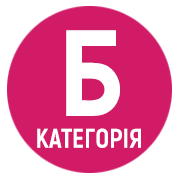Requirements for execution
The volume of the article is 10–20 pages (Main part). Font – Times New Roman, size – 14, line spacing – 1.5, margins – all 2 cm, paragraph – 1.25 cm. Formatting paragraphs with spaces (spaces) or tabs is not allowed. In the text it is necessary to use quotation marks only of such sample: "". Transfers are prohibited in the text. Page numbering is not conducted.
The UDC index (universal decimal classifier) is placed in front of the title of the article, a separate line, in the upper left corner. The author determines the UDC index.
Information about the author (authors) is indicated in English and Ukrainian after the UDC index (command – text width alignment) with indication of surname and name, academic degree and academic title, position, place of work and its full address, e-mail of each co-author; line below – ORCID number (http://orcid.org/), Scopus-Author ID (indicated in the presence of indexed publications in Scopus). All information is given in the nominative case. The name of the author (authors) is highlighted in bold and italics, other information – only in italics. Available in Ukrainian and English. The ORCID number and Scopus-Author ID are determined by the author.
Bibliographic description of the article (submitted by the editors).
The title of the article in Ukrainian and English (all uppercase letters).
The abstract is submitted in Ukrainian and English (at least 1,800 characters with spaces in each annotation). If the article is submitted in Polish, the abstract is submitted in three languages. The abstract is submitted in accordance with the requirements of scientometric databases as a structured abstract, and should contain the following selected elements: purpose of work, methodology, scientific novelty, conclusions.
Key words – words from the text of the material, which from the point of view of information retrieval carry a meaningful load. Key words are presented in the nominative case, the total number of keywords - not less than three and not more than seven, are presented in Ukrainian and English.
The main part of the article should contain the following structural elements:
• urgency of the problem;
• analysis of recent research and publications (only a list of surnames is not allowed);
• purpose and main objectives of the study;
• presentation of the main research material;
• conclusions and prospects for further exploration of this issue;
• bibliography / References.
References in the text are put in round brackets: an author’s surname – comma – publication year – comma – pages which contain information the author refer to (Bibikov, 2010, pp. 25–34). References to several pages are presented simultaneously by a semicolon (Bibikov, 2010; Pietrov, 2007; Ivanov, 2015), the indication of pages is optional.
Bibliography must involve at least 10 items in source languages (exception – Chinese, Japanese, Korean and Arabic). In that case, a source should be translated into English with the indication of a source language in square brackets. Bibliographic entry is executed taking into account developed in 2015 the National Standard of Ukraine DSTU 8302: 2015 “Information and documentation. Bibliographic reference. General principles and rules of composition”.
At the end of the article is a transliterated and translated into English version of the literature (References), designed in accordance with the agreements of the APA (American Psychological Association).
The amount of tabular material and figures should not be excessive. The digital material is presented in a table which has a serial number (for example, Table 1 (in italics) and a title (printed above the table in the middle in bold). Figures should also be numbered and have names, which are indicated under each of the figures in the normal font (for instance, Fig. 2. Dynamics of sugar production in Ukraine in 2013–2019).
Figures made in MS Word need to be grouped; they must be represented by a single graphic object. For figures made in Excel, you need to send an Excel file in addition to the article.
Formulas are executed using the built-in MS Equtation formula editor and are numbered to the right.
When submitting the article, it is essential to take into account that the journal has black-and-white print and thus, the use of different colors, especially when using multicolor graphics and diagrams, doesn’t ensure their adequate presentation in printed copies. The editors recommend using patterned filling of diagram segments in black and white.
EXAMPLE OF THE ARTICLE EXECUTION:
УДК 621.315.592
Галина МИРОНЧУК
дoктop фiзикo-мaтемaтичних нaук, професор, директор навчально-наукового фізико-технологічного інституту, Вoлинcький нaцioнaльний унiвеpcитет iменi Леci Укpaїнки, пp. Вoлi 13, м. Луцьк, Укpaїнa, 43025
ORCID ID: https://orcid.org/0000-0002-9088-3825
SCOPUS-AUTHOR ID: 36245422900
Бібліографічний опис статті: Мирончук, Г. (2021). Фотоіндуковані ефекти першого порядку в халькогенідних системах Ag-Ga(In)-Si(Ge)-S(Se). Освітні технології, 2, 3–10, doi:
ФОТОІНДУКОВАНІ ЕФЕКТИ ПЕРШОГО ПОРЯДКУ В ХАЛЬКОГЕНІДНИХ СИСТЕМАХ Ag-Ga(In)-Si(Ge)-S(Se)
Анотація ... (не менше 1800 символів із пробілами)
Ключові слова: напівпровідники, оптичне поглинання, фотоіндуковані ефекти, електрон-фононна взаємодія.
Galina MYRONCHUK
Doctor of Physical and Mathematical Sciences, Professor, Director of the Educational and Scientific Institute of Physics and Technology, Lesya Ukrainka Volyn National University, 13 Volya Ave., Lutsk, Volyn region, Ukraine, 43025
ORCID ID: https://orcid.org/0000-0002-9088-3825
SCOPUS-AUTHOR ID: 36245422900
To cite this article: Myronchuk, G. (2021). Fotoindukovani efekty pershoho poriadku v khalkohenidnykh systemakh Ag-Ga(In)-Si(Ge)-S(Se) [Photo-induced effects first order in chalcohenid systems of Ag-Ga (In) -Si (Ge)-S (Se)]. Educational technology, 2, 3–10, doi:
PHOTO-INDUCED EFFECTS FIRST ORDER IN CHALCOHENID SYSTEMS OF Ag-Ga (In) -Si (Ge) -S (Se)
Summary ... (не менше 1800 символів із пробілами)
Key words: semiconductors, optical absorption, photoinduced effects, electron-phonon interaction
Основний текст статті ... (Майер, 2015).
BIBLIOGRAPHY:
- Гончаренко С.У. Педагогічні дослідження: методологічні поради молодим науковцям. Вінниця: ДОВ «Вінниця», 2008. 278 с.
REFERENCES:
-
Honcharenko, S.U. (2008). Pedahohichni doslidzhennia: metodolohichni porady molodym naukovtsiam [Pedagogical research: methodological advice for young scientists]. Vinnytsia: DOV «Vinnytsia». 278 s. [in Ukrainian].







